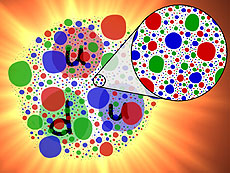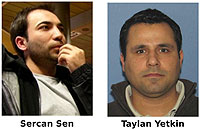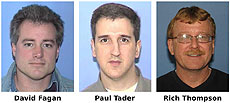Peering deeper into the proton
 |
When probed at smaller scales, protons seem to contain more and more quarks and gluons, represented here as colored blobs.
|
The LHC may help us discover new laws of physics, but it is already improving our understanding of the laws we thought we knew. Quantum Chromodynamics (QCD) is the force law that describes the attraction between quarks. It is believed to be correct because it made many predictions that were confirmed experimentally in the 1970s and 1980s. However, QCD is too mathematically complex to solve in general - only special cases have been precisely calculated.
One problem that has not been solved is the detailed structure of protons and neutrons, which together make up most of the everyday world. Both contain three primary quarks (up, up, down for protons and down, down, up for neutrons), a froth of quark-antiquark pairs appearing out of the vacuum and annihilating with each other and a swarm of gluons holding them all together. But how many? How strongly do they all stick together? These are hard questions to answer from the fundamental theory.
Experiments reveal this structure in protons by colliding them and observing how much energy is released at different angles. Higher-energy collisions are privy to finer detail, like microscopes with higher resolving power, because they are quick enough to get a snapshot of the short-lived quark-antiquark pairs and gluons before they fluctuate away. The LHC provides the sharpest image yet.
The experiments show that the closer you look, the more of these quarks and gluons you see, especially gluons. In fact, there are so many at the scales probed by the LHC that sometimes more than two of them collide when two protons pass through each other. In a recent paper, CMS physicists demonstrate that their measurements are more consistent with multiple quark/gluon interactions than any other known process.
This has many implications. It may indicate a transition to a new regime of QCD, where the density of quarks and gluons saturates - that is, they become so dense that they start overlapping and interacting in new ways. These effects are interesting in their own right, but they are also necessary to predict probabilities for creating new known and unknown particles.
—Jim Pivarski
 |
The two University of Iowa physicists pictured above made important contributions to this analysis.
|
 |
The Computing Infrastructure Group in the CMS Computing Facilities Department installs, deploys, administers and troubleshoots thousands of Linux servers and worker nodes and more than 15,000 TB of storage.
|
|